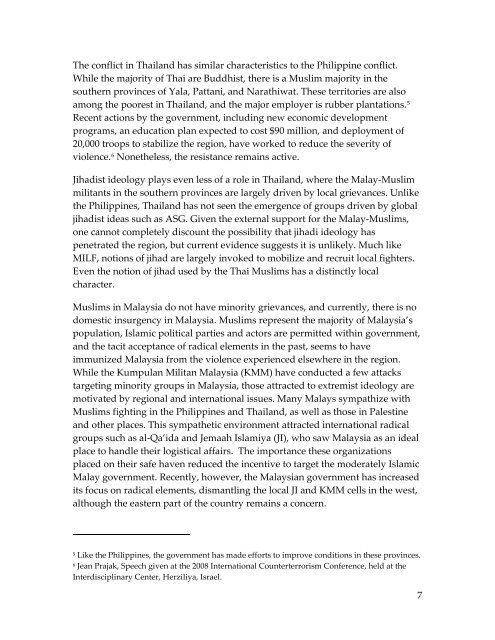Create successful ePaper yourself
Turn your PDF publications into a flip-book with our unique Google optimized e-Paper software.
The conflict in Thailand has similar characteristics to the Philippine conflict.<br />
While the majority of Thai are Buddhist, there is a Muslim majority in the<br />
southern provinces of Yala, Pattani, and Narathiwat. These territories are also<br />
among the poorest in Thailand, and the major employer is rubber plantations. 5<br />
Recent actions by the government, including new economic development<br />
programs, an education plan expected to cost $90 million, and deployment of<br />
20,000 troops to stabilize the region, have worked to reduce the severity of<br />
violence. 6 Nonetheless, the resistance remains active.<br />
Jihadist ideology plays even less of a role in Thailand, where the Malay-Muslim<br />
militants in the southern provinces are largely driven by local grievances. Unlike<br />
the Philippines, Thailand has not seen the emergence of groups driven by global<br />
jihadist ideas such as ASG. Given the external support for the Malay-Muslims,<br />
one cannot completely discount the possibility that jihadi ideology has<br />
penetrated the region, but current evidence suggests it is unlikely. Much like<br />
MILF, notions of jihad are largely invoked to mobilize and recruit local fighters.<br />
Even the notion of jihad used by the Thai Muslims has a distinctly local<br />
character.<br />
Muslims in Malaysia do not have minority grievances, and currently, there is no<br />
domestic insurgency in Malaysia. Muslims represent the majority of Malaysia’s<br />
population, Islamic political parties and actors are permitted within government,<br />
and the tacit acceptance of radical elements in the past, seems to have<br />
immunized Malaysia from the violence experienced elsewhere in the region.<br />
While the Kumpulan Militan Malaysia (KMM) have conducted a few attacks<br />
targeting minority groups in Malaysia, those attracted to extremist ideology are<br />
motivated by regional and international issues. Many Malays sympathize with<br />
Muslims fighting in the Philippines and Thailand, as well as those in Palestine<br />
and other places. This sympathetic environment attracted international radical<br />
groups such as al-Qa’ida and Jemaah Islamiya (JI), who saw Malaysia as an ideal<br />
place to handle their logistical affairs. The importance these organizations<br />
placed on their safe haven reduced the incentive to target the moderately Islamic<br />
Malay government. Recently, however, the Malaysian government has increased<br />
its focus on radical elements, dismantling the local JI and KMM cells in the west,<br />
although the eastern part of the country remains a concern.<br />
5<br />
Like the Philippines, the government has made efforts to improve conditions in these provinces.<br />
6<br />
Jean Prajak, Speech given at the 2008 International Counterterrorism Conference, held at the<br />
Interdisciplinary Center, Herziliya, Israel.<br />
7


